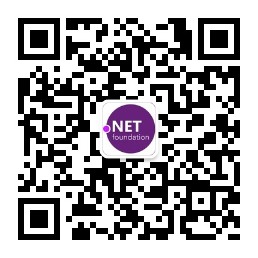前言
这篇文章拖太久了,因为最近实在太忙了,加上这篇文章也非常长,所以花了不少时间,给大家说句抱歉。好,进入正题。目前的项目基本都是前后端分离了,前端分Web,Ios,Android。。。,后端也基本是Java,.NET的天下,后端渲染页面的时代已经一去不复返,当然这是时代的进步。前端调用后端服务目前大多数基于JSON的HTTP服务,那么就引入的我们今天的内容。客户端访问服务的时候怎么保证安全呢?很多同学都听说过OAuth2.0,都知道这个是用来做第三方登录的,实际上它也可以用来做Api的认证授权。不懂OAuth的同学可以先去看看阮一峰的OAuth的讲解,如果你看不懂的话,那就对了,笔者当初也看了很久,结合实际项目才明白。这章我会结合具体的例子帮助大家理解。同时也也会结合前几章的内容做一个整合,让大家对微服务架构以及API授权有一个更清晰的认识。
业务场景
程序清单列表
- 服务中心
- API网关
- 认证授权中心
- 用户中心
-
订单中心
用户中心和认证授权中心有耦合的情况,访问认证授权的时候要去验证用户的账号密码是否合法
下图是一个简单的架构草图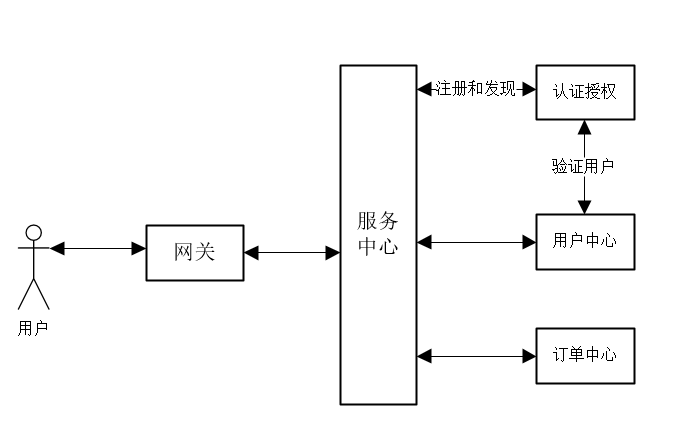
服务中心和API网关大家看之前的文章来搭建,也可以直接看github上的源代码,没有什么变化。
认证授权中心
一直在说Ids4(IdentityServer4)这个框架,它实际上是一个实现了OAuth+OIDC(OpenId Connect)这两个功能的解决方案。那么OAuth和OIDC又到底是什么东西呢?简单来说OAuth就是帮助我们做授权获取token的,而OIDC就是帮助我们做认证这个token合法性的。一个完整的授权认证系统应该包含这两个功能。那么我们再谈一谈token,Ids4提供2种完全不一样的token加密方式,一种是JWT另一种叫Reference。那么这两种加密方式有何不同呢?JWT就是对这个字符串的一个加密算法,这个字符串包含了用户信息,客户端可以直接解析token,拿到用户信息,不需要和认证服授权务器去交互(程序首次加载的时候交互一次)。Reference更像Session,需要和认证服务器交互,由认证授权服务器去验证是否合法,每一次访问都需要和认证服务器进行交互,并且用户信息也是通过认证成功以后返回的。这两种方式各有优缺点。
JWT是一种加密方式,那么认证服务器不需要对token进行存储,而客户端也不需要找服务端验证,那么对于程序的性能是有很大的提升的,也不用考虑分布式和存储的问题,但是对于生成的token没办法控制,只能通过时效性来过期。
Reference的方式,token需要考虑分布式的存储,而且客户端需要一直和服务端认证,有一定的性能损耗,但是服务端可以对token进行控制,比如登出用户,修改密码都可以作废掉已经生成的token,这个时候再拿这个token是没办法使用的。然而不管是APP还是WEB让用户主动登出操作这是一个非常伪的需求,实际上即使是Reference方式token依然靠时效性来控制。
那么问题来了,当你的上级不懂技术的时候,问你万一我的token泄露了怎么办?你可以这样回答他。如果是在传输过程中的泄露,那么我们可以通过HTTPS的方式加密。程序代码里面用户相关的操作,都应该对传递的UserId参数和token里面解析出来UserId进行比较,如果出现不一致,那么这一定是一个非法请求。例如张三拿着李四的token去修改密码,肯定是修改不成功的。如果是在用户的客户端(WEB,APP)就把token泄露了,那么这个实际上这个客户端已经不止token泄露这么简单了,包括他所有的用户信息都泄露了,这个时候token已经没有了意义。就好比腾讯QQ加密算法做的如何如何牛逼,但是你泄露了你的QQ号和密码...
我们可以在过期时间上尽量短一点,客户端通过刷新token的方式不断获取新的token,而达到用户不用重复的登录,就能一直访问API接口。
至于两种方式的安全性我觉得都一样,微服务中我更倾向JWT这种方式,简单,高效。下面的代码我会模拟这两种模式,至于具体选择哪种方式大家根据实际的业务需求来。
小插曲:和几位技术大牛经过激烈的讨论,大家一致认为服务与服务之间的通信也是需要认证的,这样虽然增加了一定的性能损耗但是却更加的安全。我觉得有句话说的非常好,原则上内部其它系统都是不可信的。所以微服务之间的访问也得认证。
Reference方式的token,Ids4默认采用的内存做存储,也提供了EF for MS SQL 做分布式存储,而我们这里并不采用这种方式,我们采用redis来作为token的存储。
添加nuget引用
<PackageReference Include="Foundatio.Redis" Version="5.1.1478" /> <PackageReference Include="IdentityServer4" Version="2.0.2" /> <PackageReference Include="Pivotal.Discovery.Client" Version="1.1.0" />
Config.cs
配置Client信息,我们创建2个Client,一个采用JWT,一个采用Reference方式
new Client
{
ClientId = "client.jwt",
ClientSecrets =
{ new Secret("AB2DC090-0125-4FB8-902A-34AFB64B7D9B".Sha256())
},
AllowedGrantTypes = GrantTypes.ResourceOwnerPassword,
AllowOfflineAccess = true,
AccessTokenLifetime = accessTokenLifetime,
AllowedScopes =
{ "api1"
},
AccessTokenType =AccessTokenType.Jwt
}new Client
{
ClientId = "client.reference",
ClientSecrets =
{ new Secret("A30E6E57-086C-43BE-AF79-67ADECDA0A5B".Sha256())
},
AllowedGrantTypes = GrantTypes.ResourceOwnerPassword,
AllowOfflineAccess = true,
AccessTokenLifetime = accessTokenLifetime,
AllowedScopes =
{ "api1"
},
AccessTokenType =AccessTokenType.Reference
},
RedisPersistedGrantStore.cs
实现IPersistedGrantStore接口来支持redis
public class RedisPersistedGrantStore : IPersistedGrantStore{ private readonly ICacheClient _cacheClient; private readonly IConfiguration _configuration; public RedisPersistedGrantStore(ICacheClient cacheClient, IConfiguration configuration) {
_cacheClient = cacheClient;
_configuration = configuration;
} public Task StoreAsync(PersistedGrant grant) { var accessTokenLifetime = double.Parse(_configuration.GetConnectionString("accessTokenLifetime")); var timeSpan = TimeSpan.FromSeconds(accessTokenLifetime);
_cacheClient?.SetAsync(grant.Key, grant, timeSpan); return Task.CompletedTask;
} public Task<PersistedGrant> GetAsync(string key) { if (_cacheClient.ExistsAsync(key).Result)
{ var ss = _cacheClient.GetAsync<PersistedGrant>(key).Result; return Task.FromResult<PersistedGrant>(_cacheClient.GetAsync<PersistedGrant>(key).Result.Value);
} return Task.FromResult<PersistedGrant>((PersistedGrant)null);
} public Task<IEnumerable<PersistedGrant>> GetAllAsync(string subjectId)
{ var persistedGrants = _cacheClient.GetAllAsync<PersistedGrant>().Result.Values; return Task.FromResult<IEnumerable<PersistedGrant>>(persistedGrants
.Where(x => x.Value.SubjectId == subjectId).Select(x => x.Value));
} public Task RemoveAsync(string key) {
_cacheClient?.RemoveAsync(key); return Task.CompletedTask;
} public Task RemoveAllAsync(string subjectId, string clientId) {
_cacheClient.RemoveAllAsync(); return Task.CompletedTask;
} public Task RemoveAllAsync(string subjectId, string clientId, string type) { var persistedGrants = _cacheClient.GetAllAsync<PersistedGrant>().Result.Values
.Where(x => x.Value.SubjectId == subjectId && x.Value.ClientId == clientId &&
x.Value.Type == type).Select(x => x.Value); foreach (var item in persistedGrants)
{
_cacheClient?.RemoveAsync(item.Key);
} return Task.CompletedTask;
}
}
ResourceOwnerPasswordValidator.cs
实现IResourceOwnerPasswordValidator接口实现自定义的用户验证逻辑
public class ResourceOwnerPasswordValidator : IResourceOwnerPasswordValidator{
private readonly DiscoveryHttpClientHandler _handler;
private const string UserApplicationName = "user";
public ResourceOwnerPasswordValidator(IDiscoveryClient client) {
_handler = new DiscoveryHttpClientHandler(client);
}
public async Task ValidateAsync(ResourceOwnerPasswordValidationContext context) {
//调用用户中心的验证用户名密码接口
var client = new HttpClient(_handler);
var url = $"http://{UserApplicationName}/search?name={context.UserName}&password={context.Password}";
var result = await client.GetAsync(url);
if (result.IsSuccessStatusCode)
{
var user = await result.Content.ReadAsObjectAsync<dynamic>();
var claims = new List<Claim>() { new Claim("role", user.role.ToString()) };
context.Result = new GrantValidationResult(user.id.ToString(), OidcConstants.AuthenticationMethods.Password, claims);
}
else
{
context.Result = new GrantValidationResult(null);
}
}
}
var claims = new List<Claim>() { new Claim("key", "value") };
这里可以传递自定义的用户信息,在客户端通过User.Claims.FirstOrDefault(x => x.Type == "key")来获取
这里需要注意一下,因为这里走的是http所以,授权服务中心和用户中心存在耦合,我个人建议如果走JWT的方式,用户中心和认证授权中心可以合并成一个服务,如果采用Reference的方式,建议还是拆分。
Startup.cs
public void ConfigureServices(IServiceCollection services){
services.AddDiscoveryClient(Configuration);
var redisconnectionString = Configuration.GetConnectionString("RedisConnectionString");
var config = new Config(Configuration);
services.AddMvc();
services.AddIdentityServer({
x.IssuerUri = "http://identity";
x.PublicOrigin = "http://identity";
})
.AddDeveloperSigningCredential()
.AddInMemoryPersistedGrants()
.AddInMemoryApiResources(config.GetApiResources())
.AddInMemoryClients(config.GetClients());
services.AddSingleton(ConnectionMultiplexer.Connect(redisconnectionString));
services.AddTransient<ICacheClient, RedisCacheClient>();//注入redis
services.AddSingleton<IPersistedGrantStore, RedisPersistedGrantStore>();
services.AddTransient<IResourceOwnerPasswordValidator, ResourceOwnerPasswordValidator>();
}
public void Configure(IApplicationBuilder app, IHostingEnvironment env){
if (env.IsDevelopment())
{
app.UseDeveloperExceptionPage();
}
app.UseMvc();
app.UseDiscoveryClient();
app.UseIdentityServer();
}
因为是采用服务发现的方式,所以我们这里要修改IssuerUri和PublicOrigin。不要让发现服务暴露自己的具体URL地址,否则这里就负载不均衡了。
appsettings.json
"ConnectionStrings": {
"RedisConnectionString": "localhost",
"AccessTokenLifetime": 3600 //token过期时间 单位秒
},
"spring": {
"application": {
"name": "identity"
}
},
"eureka": {
"client": {
"serviceUrl": "http://localhost:5000/eureka/"
},
"instance": {
"port": 8010
}
}
用户中心
用户中心主要实现2个接口,一个给授权中心验证用户使用,还有一个是给客户端登录的时候返回token使用
nuget引用
<PackageReference Include="IdentityModel" Version="2.14.0" /> <PackageReference Include="Pivotal.Discovery.Client" Version="1.1.0" />
appsettings.json
{ "spring": {
"application": {
"name": "user"
}
},
"eureka": {
"client": {
"serviceUrl": "http://localhost:5000/eureka/"
},
"instance": {
"port": 8040,
"hostName": "localhost"
}
},
"IdentityServer": {
//jwt "ClientId": "client.jwt", "ClientSecrets": "AB2DC090-0125-4FB8-902A-34AFB64B7D9B"
//reference
//"ClientId": "client.reference",
//"ClientSecrets": "A30E6E57-086C-43BE-AF79-67ADECDA0A5B"
}
}
ValuesController.cs
[Route("/")]
public class ValuesController : Controller{
private const string IdentityApplicationName = "identity";
private readonly DiscoveryHttpClientHandler _handler;
private readonly IConfiguration _configuration;
public ValuesController(IDiscoveryClient client, IConfiguration configuration) {
_configuration = configuration;
_handler = new DiscoveryHttpClientHandler(client);
}
[HttpGet("search")]
public IActionResult Get(string name, string password) {
var account = Account.GetAll().FirstOrDefault(x => x.Name == name && x.Password == password);
if (account != null)
{
return Ok(account);
}
else
{
return NotFound();
}
}
[HttpPost("Login")]
public async Task<IActionResult> Login([FromBody] LoginRequest input) {
var discoveryClient = new DiscoveryClient($"http://{IdentityApplicationName}", _handler)
{
Policy = new DiscoveryPolicy { RequireHttps = false }
};
var disco = await discoveryClient.GetAsync();
if (disco.IsError) throw new Exception(disco.Error);
var clientId = _configuration.GetSection("IdentityServer:ClientId").Value;
if (string.IsNullOrEmpty(clientId)) throw new Exception("clientId is not value.");
var clientSecrets = _configuration.GetSection("IdentityServer:ClientSecrets").Value;
if (string.IsNullOrEmpty(clientSecrets)) throw new Exception("clientSecrets is not value.");
var tokenClient = new TokenClient(disco.TokenEndpoint, clientId, clientSecrets, _handler);
var response = await tokenClient.RequestResourceOwnerPasswordAsync(input.Name, input.Password, "api1 offline_access");//如果需要刷新token那么这里要多传递一个offline_access参数,不传的话RefreshToken为null
var response = await tokenClient.RequestResourceOwnerPasswordAsync(input.Name, input.Password, "api1");
if (response.IsError) throw new Exception(response.Error);
return Ok(new LoginResponse()
{
AccessToken = response.AccessToken,
ExpireIn = response.ExpiresIn,
RefreshToken = response.RefreshToken
});
}
}
这里offline_access这个参数很重要,如果你需要刷新token必须传这个参数,传递了这个参数以后redis服务器会记录,通过refreshToken来获取一个新的accessToken,这里就不做演示了,Ids4的东西太多了,更细节的东西大家去关注Ids4的内容
Account.cs
提供2个用户,各有不同的角色
public class Account
{
public string Name { get; set; }
public string Password { get; set; }
public int Id { get; set; }
public string Role { get; set; }
public static List<Account> GetAll() {
return new List<Account>()
{ new Account()
{
Id = 87654,
Name = "leo",
Password = "123456",
Role = "admin"
}, new Account()
{
Id = 45678,
Name = "mickey",
Password = "123456",
Role = "normal"
}
};
}
}
订单中心
nuget引用
<PackageReference Include="IdentityServer4.AccessTokenValidation" Version="2.1.0" /> <PackageReference Include="Pivotal.Discovery.Client" Version="1.1.0" />
Startup.cs
public void ConfigureServices(IServiceCollection services){
services.AddDiscoveryClient(Configuration);
var discoveryClient = services.BuildServiceProvider().GetService<IDiscoveryClient>();
var handler = new DiscoveryHttpClientHandler(discoveryClient);
services.AddAuthorization();
services.AddAuthentication(x =>
{
x.DefaultChallengeScheme = JwtBearerDefaults.AuthenticationScheme;
x.DefaultAuthenticateScheme = JwtBearerDefaults.AuthenticationScheme;
})
.AddIdentityServerAuthentication(x =>
{
x.ApiName = "api1";
x.ApiSecret = "secret";
x.Authority = "http://identity";
x.RequireHttpsMetadata = false;
x.JwtBackChannelHandler = handler;
x.IntrospectionDiscoveryHandler = handler;
x.IntrospectionBackChannelHandler = handler;
});
services.AddMvc();
}
这里需要注意的一点是handler,Ids4竟然在参数里面有handler的参数,这样我们接入微服务里面的服务发现简直太easy了。同时这里也给大家一个启发,我们再做第三方接口的时候,一定要参数齐全,哪怕这个参数并不会被大多数情况下使用,如果Ids4没提供这个参数,那么我就需要重写一套验证逻辑了。
ValuesController.cs
添加4个接口,针对不同的角色用户
[Route("/")]
public class ValuesController : Controller{ // admin role
[HttpGet("admin")]
[Authorize(Roles = "admin")]
public IActionResult Get1() {
var userId = User.Claims.FirstOrDefault(x => x.Type == "sub")?.Value;
var role = User.Claims.FirstOrDefault(x => x.Type == "role")?.Value;
return Ok(new { userId, role });
} // normal role
[HttpGet("normal")]
[Authorize(Roles = "normal")]
public IActionResult Get2() {
var userId = User.Claims.FirstOrDefault(x => x.Type == "sub")?.Value;
return Ok(new { role = "normal", userId = userId });
} // any role
[HttpGet("any")]
[Authorize]
public IActionResult Get3() {
var userId = User.Claims.FirstOrDefault(x => x.Type == "sub")?.Value;
return Ok(new { role = "any", userId = userId });
} // Anonymous
[HttpGet]
[AllowAnonymous]
public IActionResult Get() {
return Ok(new { role = "allowAnonymous" });
}
}
演示部分
JWT
分别运行这个5个应用程序,访问http://localhost:5000
如图表示,全部运行成功。
通过postman模拟用户登录,通过api网关地址访问。
url:http://localhost:5555/user/login
method:post
requestBody:
{
"name":"leo",
"password":"123456"
}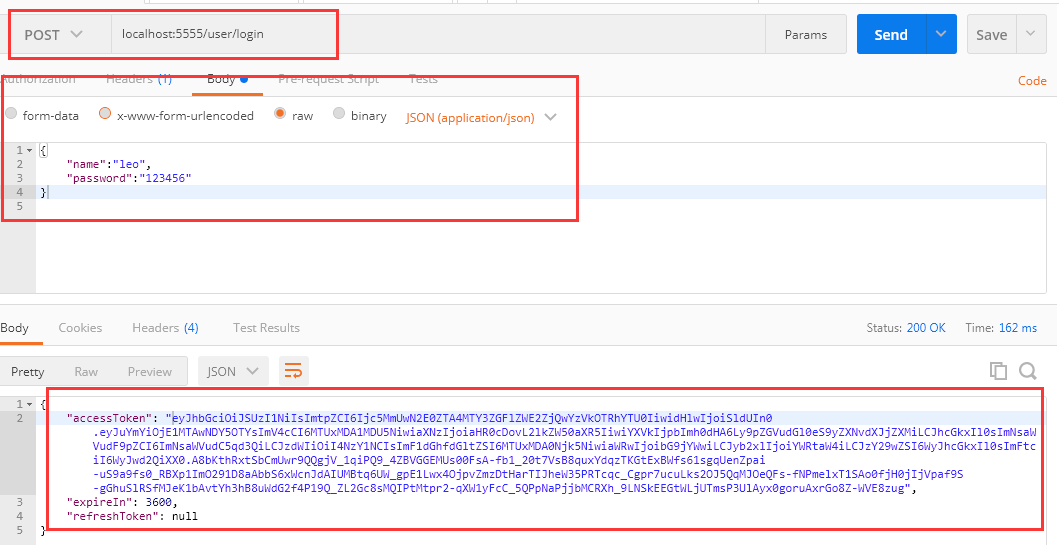
拿到token后,我们再访问订单中心的地址。
url:http://locahost:5555/order/admin
mothod:get
header: Authorization:bearer token(bearer和token中间有一个空格)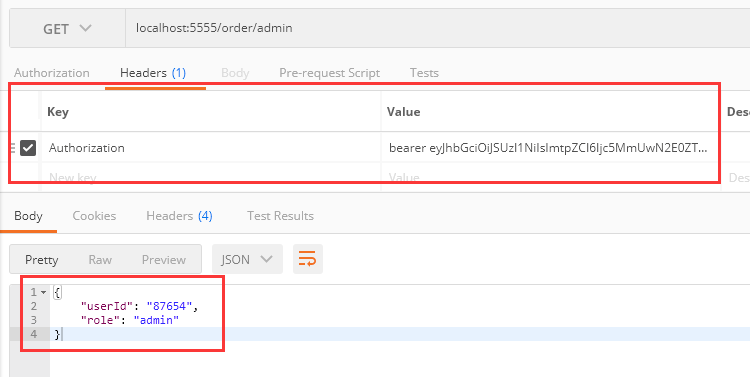
成功返回userId和role信息
我们随意修改一下token的字符串再访问,会返回401,认证不会通过。
这里需要注意的是zuul默认不支持header的传递,需要在网关服务里面增加一个配置zuul.sensitive-headers=true
这个时候我们修改url地址http://locahost:5555/order/normal
返回了403表示这个接口没有权限
再修改地址访问http://locahost:5555/order/any
这个接口只要授权用户都可以访问。
最后这个接口http://locahost:5555/order就比较容易理解是一个匿名用户都可以访问的接口不用做身份验证,我们去掉header信息
我们可以再试试另一个用户mickey/123456试试,篇幅有限,这里就不再做描述了,mickey这个用户拥有http://locahost:5555/order/normal这个接口的访问权限。
Reference
切换一下配置文件,来支持reference,修改User项目的appsettings.json文件
"IdentityServer": { //"ClientId": "client.jwt", //"ClientSecrets": "AB2DC090-0125-4FB8-902A-34AFB64B7D9B", "ClientId": "client.reference", "ClientSecrets": "A30E6E57-086C-43BE-AF79-67ADECDA0A5B"
}
重新运行程序
通过postman模拟用户登录,通过api网关地址访问。
url:http://localhost:5555/user/login
method:post
requestBody:
{
"name":"leo",
"password":"123456"
}
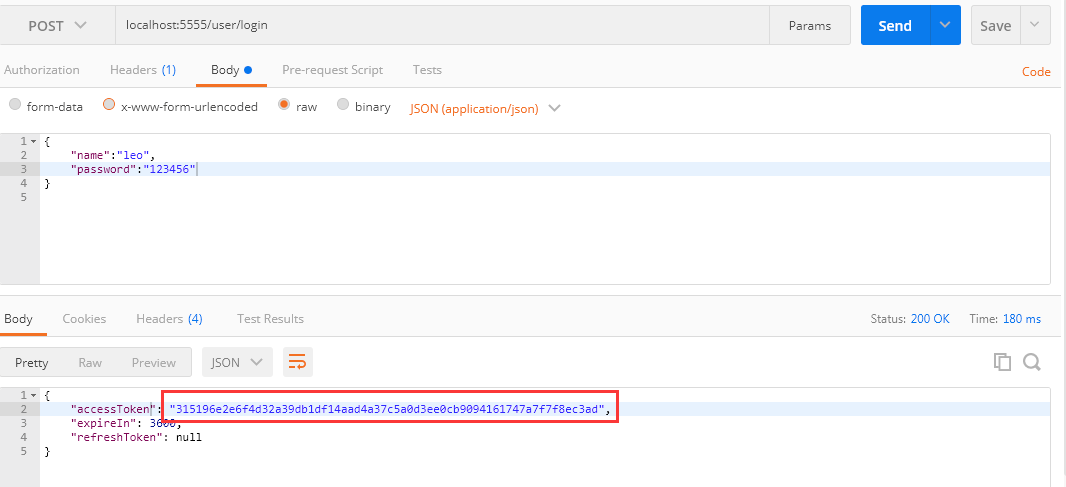
我们可以看到accessToken和JWT的完全不一样,很短的一个字符串,这个时候我们打开redis客户端可以找个这个信息
用户信息是保存在了redis里面。这里的key是通过加密的方式生成的。
拿到token后,我们再访问订单中心的地址。
url:http://locahost:5555/order/admin
mothod:get
header: Authorization:bearer token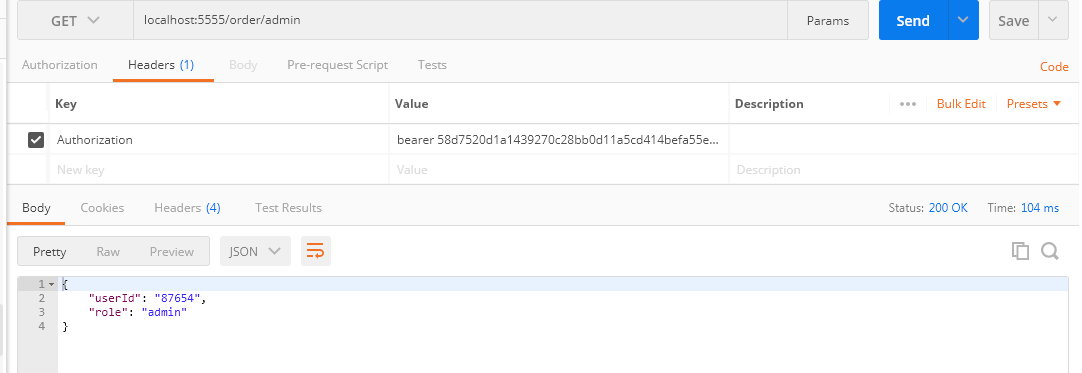
验证成功,后面的几个接口和上面一样,同学们自己来演示。
后记
通过上面的例子,我们把整个授权认证流程都走了一遍(JWT和Reference),通过Postman来模拟客户端的请求,Ids4的东西实在是太多,我没办法在这里写的太全,大家可以参考一下园子里面关于Ids4的文章。这篇文章例子比较多,强烈建议大家先下载代码,跟着博客的流程走一次,然后自己再按照步骤写一遍,这样才能加深理解。顺便给自己打个广告,笔者目前正在考虑新的工作机会,如果贵公司需要使用.NET core来搭建微服务平台,我想我非常合适。我的邮箱240226543@qq.com。
关于授权认证部分大家可以看看园子里面雨夜朦胧的博客,他通过源代码分析写的非常透彻。
示例代码
所有代码均上传github。代码按照章节的顺序上传,例如第一章demo1,第二章demo2以此类推。
求推荐,你们的支持是我写作最大的动力,我的QQ群:328438252,交流微服务。
原文地址: http://www.cnblogs.com/longxianghui/p/7800316.html
